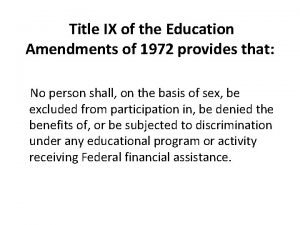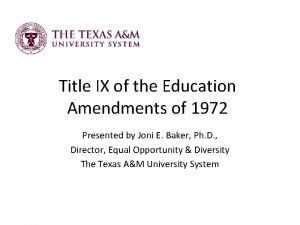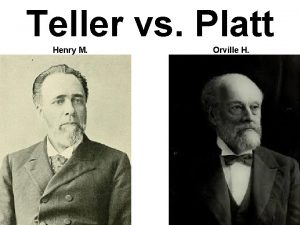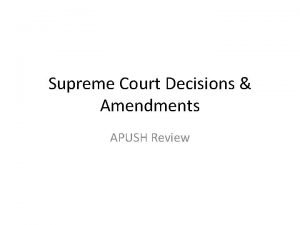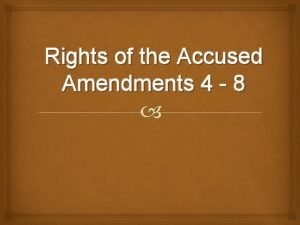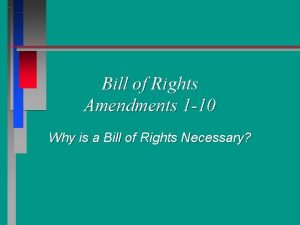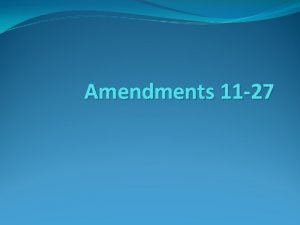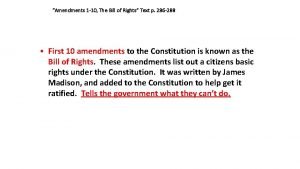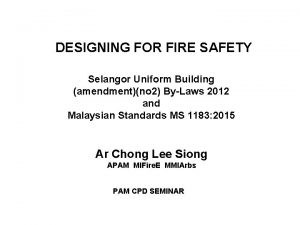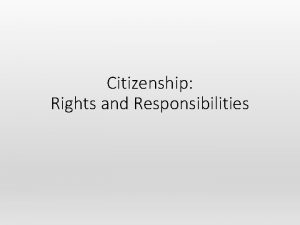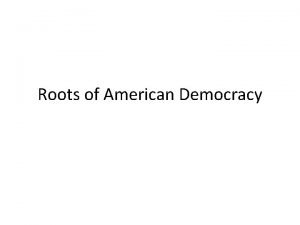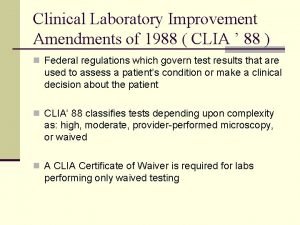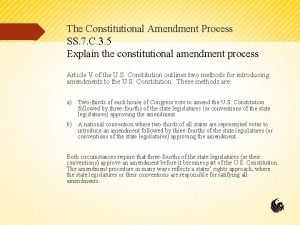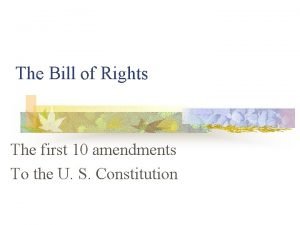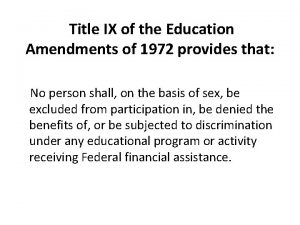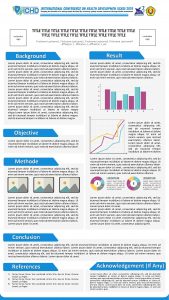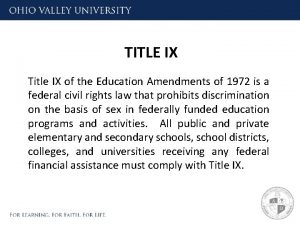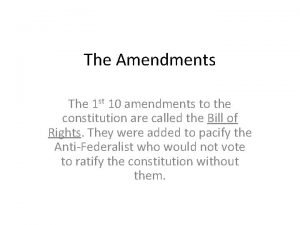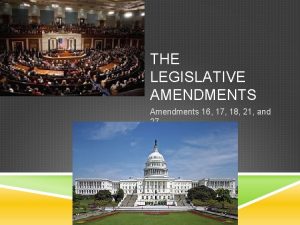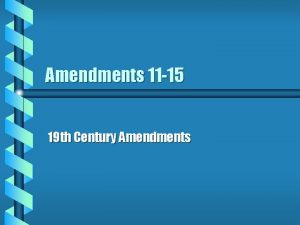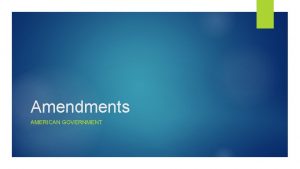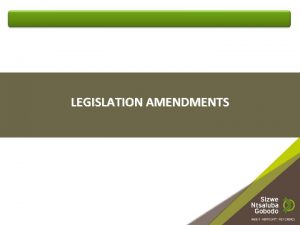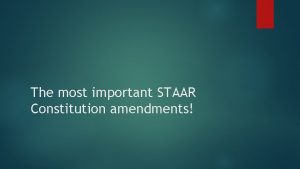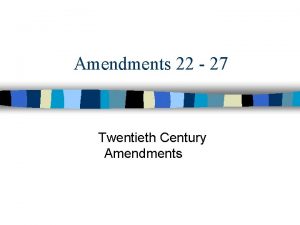Title IX of the Education Amendments of 1972




























- Slides: 28

Title IX of the Education Amendments of 1972 provides that: No person shall, on the basis of sex, be excluded from participation in, be denied the benefits of, or be subjected to discrimination under any educational program or activity receiving Federal financial assistance.

Under Title IX: • If a school knows – or even if it should know – of possible sexual harassment, including assault, • It must take immediate and appropriate steps to Ø investigate or otherwise determine what occurred; Ø take prompt and effective steps reasonably calculated to end any harassment; Ø eliminate a hostile environment if one has been created; and Ø prevent harassment from occurring again.

Sexual Harassment is a form of discrimination on the basis of sex. There are two forms of sexual harassment: • Quid Pro Quo (this for that) harassment • Hostile environment harassment

Two Forms of Sexual Harassment Quid Pro Quo Sexual Harassment exists when there are Hostile Environment Sexual Harassment is • Unwelcome sexual advances, requests for sexual favors or other verbal or physical conduct of a sexual nature; and • Submission to or rejection of such conduct results in adverse educational or employment action. • Offering a benefit can be just as detrimental. • Unwelcome verbal or physical conduct of a sexual nature that is • Sufficiently severe, and persistent or pervasive that it • Has created an intimidating, hostile or offensive academic or work environment that has the effect of unreasonably interfering with, limiting or depriving someone of the ability to participate in or benefit from an educational program or activity.

Totality of the Circumstances • Frequency of conduct (persistent or pervasive) • Nature and severity of conduct • Physically threatening? • Humiliating? • Effect on mental or emotional state? • Directed at more than one person? • Unreasonable? • Utterance or epithet which is offensive? • First Amendment considerations?

Sexual assault and other forms of sexual violence are an extreme form of hostile environment sexual harassment. Sexual violence includes – Sexual assault (intentional, non-consensual sexual touching or intercourse, however slight, with any object; vaginal or oral penetration) – Partner or dating violence – Gender-based stalking and bullying

Force – Incapacity - Consent • Was force used to obtain sexual access? • Did the Respondent know, or should they have known, that the Complainant was incapacitated? • What clear words or actions by the Complainant gave the Respondent permission for the specific sexual activity that took place?

Force • Type of force to consider: – Physical Violence – Threats – anything that would make someone do something they wouldn’t normally have done absent the threat – Intimidation – implied threat – Coercion – the application of an unreasonable amount of pressure for sexual access (consider frequency, isolation, duration, intensity)

Force • If any type of force was used – there can be no consent. • Incapacity and Consent become irrelevant if force was used.

Incapacity • Could the Complainant make rational, reasonable decisions? (alcohol, sleep, injury, mental/cognitive impairment) • Could the Complainant appreciate the situation and address it consciously such that any consent was informed? • Did the Respondent know, or should they have known of any incapacity? What would a reasonable person have known?

Consent • What clear words or actions by the Complainant gave the Respondent permission for the specific sexual activity that took place? • Consent is – Informed – Voluntary – Active (Silence is not Consent) – Clear Words or Actions – Specific to the mutually agreed upon activity (wallet example)

Remember • No means No. But Nothing also means No. • Silence and passivity do not equal permission. • Consent can be WITHDRAWN at ANY time, as long as that withdrawal is communicated clearly by the person withdrawing consent.

Policies, Definitions, Process – The OAAEO investigation report is organized around what questions must be addressed to establish whethere is a violation under Title IX and makes a finding. – The Student Conduct Director will advised the panel on what questions must be addressed to establish whether a student conduct code provision has been violated. – Critically consider whether any questions beyond those identified by OAAEO and SCCS are relevant.

New Information • Any new information or allegations that comes up during a hearing must be redirected to the investigation process. • The role of the Panel is to be Fair and Impartial in its analysis. – Set aside assumptions and focus on the EVIDENCE.

Protocol • Questions about how the University responds to allegations of sexual misconduct are set forth below in general.

UO Protocol for Responding to Reported Issues of Sexual Harassment Consistent with our obligations under Title IX, the UO protocol for responding to reported issues of sexual harassment involves: • Resources and services are made available to those who have experienced any form of sexual harassment; • Steps are taken to stop inappropriate behavior; • The matter is investigated to the extent possible based on available information; and • Steps are taken to prevent a recurrence of inappropriate behavior.

How does protocol work for students? • When a report of possible sexual harassment of a student is received, the student is contacted by the Office of the Dean of Students about services, resources and options. o Renae De. Sautel, Sexual Violence Response Coordinator o Sheryl Eyster, Associate Dean of Students • Student has the right to choose whether or not to engage services and resources and whether to provide more information. Services are not conditional on student’s providing information.

How does protocol work for students? After contact by the Office of the Dean of Students, a student is contacted by the Office of Affirmative Action and Equal Opportunity. • The student is informed of the university’s interest in holding accountable those who engage in sexual harassment. • The student is invited to meet with the OAAEO to learn about the administrative processes for addressing sexual harassment. o Darci Heroy, Equal Opportunity Specialist • The student is informed that s/he has the right to choose whether to provide information and engage in the appropriate administrative process.

How does protocol work for students? If a student chooses to share information and participate in administrative process, s/he is asked to share what happened. • OAAEO conducts preliminary investigation to assess whethere is evidence of a possible violation of the student conduct code (student behavior) or university policy (employee behavior). • Matter is referred to Student Conduct and Community Standards (SCCS) for student behavior or the Affirmative Action Administrative Council (AAAC) for employee behavior for determination as to whether the evidence establishes a violation of policy.

How does protocol work for students? If SCCS (for students) or AAAC (for employees) determines that a student or employee engaged in behavior that violates university policy, SCCS or AAAC: • determine appropriate sanctions intended to prevent any future recurrence of the inappropriate behavior.

How does protocol work for employees? When OAAEO receives a report that a UO employee is experiencing sexual harassment, the OAAEO contacts the employee. • The employee is invited to meet with OAAEO to learn about UO policy and grievance processes for addressing issues of sexual harassment. • The employee has the right to choose whether to share more information.

Formal Grievance Processes for UO Employees Represented Employees with concerns regarding behavior by UO employees: formal process is through the collective bargaining agreement grievance process. Unrepresented Employees with concerns regarding behavior by UO employees: formal process is through the Faculty Grievance Process. All Employees with concerns regarding behavior by UO students: formal process is through Student Conduct and Community Standards.

Prohibited Discrimination and Sexual Harassment Contacts ISSUE Appropriate Contact Title IX Coordinator Penelope Daugherty OAAEO 541 -346 -3123 penny@uoregon. edu Prohibited discrimination and sexual harassment OAAEO 541 -346 -3123 Required employee reporting OAAEO 541 -346 -3123 UO protocol for responding to issues of sexual harassment and sexual violence OAAEO 541 -346 -3123

Prohibited Discrimination and Sexual Harassment Contacts ISSUE Appropriate Contact Student Conduct Code Paul Shang, Assistant Vice President and Dean of Students 541 -346 -8206 pshang@uoregon. edu Sandy Weintraub, Director Student Conduct and Community Standards 541 -346 -1140 Services and resources for student survivors of sexual harassment and violence Paul Shang, Assistant Vice President and Dean of Students 541 -346 -8206 pshang@uoregon. edu Sheryl Eyster, Associate Dean of Students 541 -346 -1156 seyster@uoregon. edu Renae De. Sautel, Sexual Violence Response and Services Coordinator 541 -346 -8194 desautel@uoregon. edu

New UO Resources for Students The University of Oregon Student Affairs Division has developed the following new resources for students: • 24/7 Crisis Line: Call 541 -346 -SATE (7233) to receive support and learn options to receive help and/or report their situation. • An Interpersonal Violence team within the University Counseling and Testing Center with counselors specially trained in working with trauma victims

New UO Resources for Students Learn more about options at SAFE. UOREGON. EDU, including access to a new pamphlet, Help for Students – A Guide for the University of Oregon Community

TITLE IX - QUICK TIPS • Be mindful of information you receive regarding behavior within the UO community that might constitute sexual harassment. • If you have reason to believe that a student or employee has been subject to sexual harassment, notify your supervisor or the Office of Affirmative Action.

TITLE IX - QUICK TIPS • Unless you are a supervisor receiving information regarding behavior by an employee you supervise, your duty is to report the information you have, not to investigate the reported incident. • Failure to report limits the UO ability to provide an environment for students and employees that is free of sexual harassment. • Failure to report when required is a performance issue, and could potentially result in personal liability.
 Title ix of the education amendments act of 1972 prohibits
Title ix of the education amendments act of 1972 prohibits Title ix of the education amendments of 1972
Title ix of the education amendments of 1972 Reports and proposals
Reports and proposals Title title
Title title Reconstruction amendments
Reconstruction amendments 1-10 amendments
1-10 amendments First 10 amendments
First 10 amendments First 10 amendments
First 10 amendments Platt and teller amendments
Platt and teller amendments Apush supreme court cases
Apush supreme court cases Amendments 4-8
Amendments 4-8 Amendment mun
Amendment mun Amendments 11 27
Amendments 11 27 Change by other means
Change by other means What are the amendments 1-10
What are the amendments 1-10 16th amendment simplified
16th amendment simplified Bill of rights amendments 1 10
Bill of rights amendments 1 10 Formal vs informal amendments
Formal vs informal amendments Travel distance ubbl
Travel distance ubbl Rights of a citizen meaning
Rights of a citizen meaning The fifth, sixth, seventh, and eighth amendments protect *
The fifth, sixth, seventh, and eighth amendments protect * Third amendment
Third amendment 10 amendments bill of rights
10 amendments bill of rights Clia'88
Clia'88 Amendment
Amendment Right to bear arms
Right to bear arms Bill of rights 10 amendments
Bill of rights 10 amendments Bill of rights 10 amendments
Bill of rights 10 amendments Amendments
Amendments
